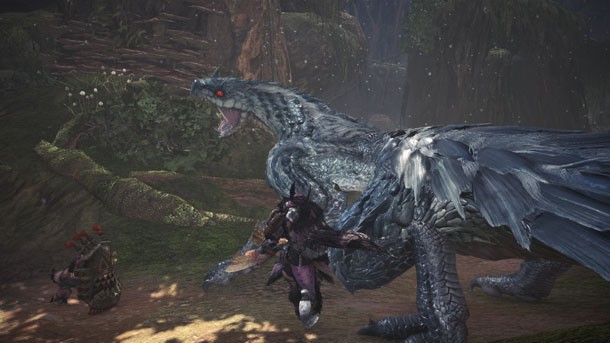Monster Hunter: World Bestiary Day 2 – The Shocking Tobi-Kadachi

Last week, we explored Monster Hunter: World’s Coral Highlands map, a striking location that looks like a dried-out version of an underwater paradise. This week, we’re taking a similar approach with three of the upcoming game’s monsters. During our visit to Capcom’s Osaka offices, we got exclusive presentations on the design process for each of these beasts, including a look at their early iterations and how they finally arrived at the versions you’ll be able to hunt in January.
On Monday, we highlighted the puffy Paolumu, a weird-looking monster that can inflate its air sac to increase its mobility. Today, we’re taking a look at the Tobi-Kadachi. This sleek predator has a shocking ability, thanks to its electrified barbs that were at least partially inspired by a device best known for personal defense. We got an in-depth look at its creation from Monster Hunter: World’s executive director and art director, Kaname Fujioka.
“For the monster designs, we try to make them flow organically from the areas they live in and what their relationship is with the environment,” Fujioka says. Tobi-Kadachi lives in the Ancient Forest map, which is loosely divided into three different biomes. Its flagship feature is a massive tree that towers over the rest of the map’s foliage. The Monster Hunter: World team wanted to capitalize on the wooded environment in an unusual way. “The initial concept was that we’re going to have this dense, rainforest-like area with high humidity, so with the monster design we wanted something that was going to utilize these trees in its attack style and how it moves.”

Monster designs are a collaborative process between artists and the game designers, Fujioka says, and Tobi-Kadachi was no exception. “We had a request from the game-design section to have this monster utilize electricity or thunder and have that tie into a certain speediness and quick movement. … We took all of these ideas and then asked the concept artist to come up with something as a starting point, and this was our initial concept for Tobi-Kadachi.”
The Monster Hunter team draws inspiration from nature when designing their monsters, and does its best to find in-universe explanations for how their various abilities function. “In order to fulfil the electric part of the concept, it’s almost like an electric catfish, where it has these whiskers that we’re going to say as a physical explanation for how it’s able to generate electricity. We always want to have a biological grounding – even if it’s fantastical – of why it’s able to do that.”
If you look at the Tobi-Kadachi’s concept art, it’s hard not to notice the flaps under its arms. “Another development we had was to focus on a flying squirrel as a starting point – the ones that kind of glide from tree to tree,” Fujioka says. “We added these tendrils to that design to give it the electricity grounding. Ultimately, while we thought it was a good design, and that it was going to be a speedy monster and it was going to be able to move fast, it didn’t give enough of a sense that this was something that would generate electricity, so it wasn’t quite there for us. Given that the electricity part was something that we were lacking in our design, the concept of the designer started from a stun gun, and that’s how we were able to be satisfied that it was actually going to shock you.”

The team shifted to a sleeker overall profile, which further informed how the creature would generate electricity. “We’re thinking of an explanation of why it can generate electricity and attack you with it, so this long fur is there. As it brushes up against things, we’re saying that it can generate static electricity, which it’s then able to store. When it wants to attack, these spikes are able to pop out of its body and that’s where it actually releases electricity that’s stored through its movements.”
Of course, designing the monster itself is only part of the process. For the armor that players can craft with Tobi-Kadachi’s body parts, the Monster Hunter: World team worked to incorporate the aesthetics of the beast as well as its electrical nature. “Obviously, Monster Hunter armor is not just pretty, it’s there to perform a function, and we usually try to have some kind of connection between the properties of the monster you’ve just beaten and the properties with the boost in stats that it’s going to give you,” Fujioka says. “In this case, the speedy movements and building up of electricity via the environmental movement are key aspects. This armor has skills which will allow you to, when you dodge, which is a very quick movement, your stamina is reduced less. The idea is that you’re storing power somehow. You also have an electrical effect as well, which is obviously a clear link to the monster itself. The weapons will also have a clear through line with electricity as well.”
As for the monster’s name, the team looked close to home. According to Fujioka, “Tobi” or “Tobu” is the Japanese verb for jumping, and “Kadachi” has its roots in the ancient Japanese word for a snake. “It also has a secondary implication of thunder to it, so there are multiple meanings built into it.”

We've got more Monster Hunter: World info planned for the days and weeks to come, so check out our content hub for more. Come back Friday for an exclusive look into the creation of one of the game's biggest threats.

Get the Game Informer Print Edition!
Explore your favorite games in premium print format, delivered to your door.
- 10 issues per year
- Only $4.80 per issue
- Full digital magazine archive access
- Since 1991










